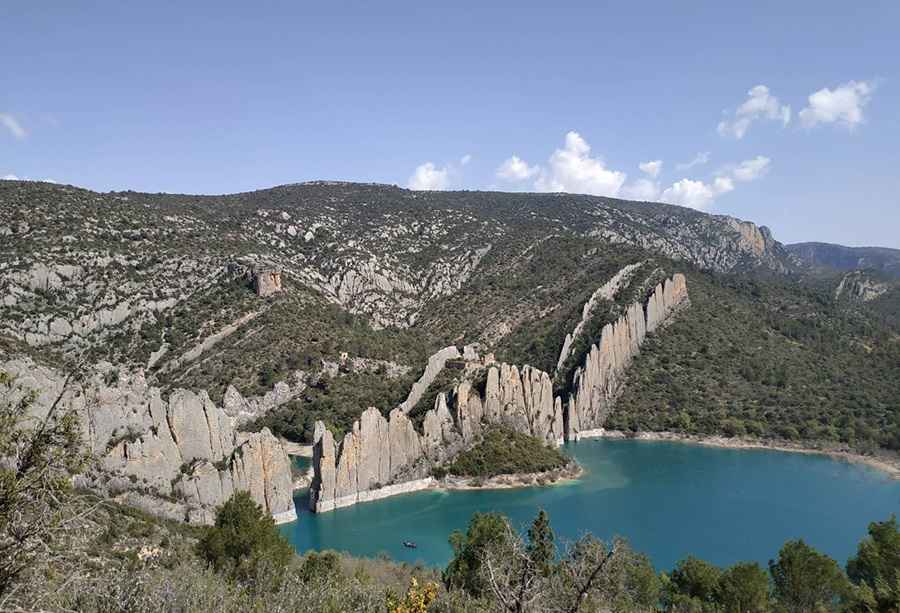How to get to Muralla de Finestres, the Chinese Wall of Spain, by car?
If you’re searching for one of Spain’s hidden natural wonders, the Muralla de Finestres is a destination that will leave you speechless. Often called the Chinese Wall of Aragón, this impressive stone formation looks like something built by ancient hands — but it’s entirely sculpted by nature. Tucked away in the wild landscapes of Huesca, it offers breathtaking views, rich history, and the perfect adventure for lovers of hiking, photography, and unique geological sites. Here’s everything you need to know before visiting this spectacular place.

What is the Muralla de Finestres?
The Muralla de Finestres, also known as Roques de la Vila, the Chinese Wall of Finestres, or the Chinese Wall of Aragón, is a completely natural geological formation. It is a giant stone wall located in the Montsec mountain range, in the Ribagorza region of Huesca province. This is a place untouched by humans and known to very few.
Where is it located?
The wall is in Huesca province, within the autonomous community of Aragón, very close to Catalonia in northern Spain.
What makes this natural wall so special?
The natural wall rises above the Canelles reservoir. For many years, it served as a natural fortress for the Finestres castle. Seeing this stunning natural formation feels like traveling back in time — like a frozen postcard from a somewhat forgotten part of Spain.
How do you get to the Muralla de Finestres?
The best starting point is the small village of Estopiñán del Castillo, reachable from Benabarre. This tiny community has only 126 residents and celebrates its local festival for San Salvador each August, including the traditional baile de los palitrocs.
Is the road accessible for all vehicles?
From Estopiñán del Castillo, there is a track leading toward the wall. However, it’s only suitable for 4x4 vehicles. The unpaved route is about 12 km long and is full of potholes, bumps, uneven slopes, and changes in gradient. It’s common for some people to attempt it with standard cars, but if they make it, it’s usually after a lot of trouble and stress. It is strongly recommended to come with an SUV or 4x4, or to park near the Penavera bridge and complete the final part of the route on foot. Even before the parking area at the Penavera bridge, the road conditions are already quite poor and not recommended for low-clearance vehicles.
What are the best viewpoints of the Muralla de Finestres?
The best ways to admire the Chinese Wall of Finestres are by taking hiking trails to two small hermitages near the formation: San Vicente and San Marcos. The paths are well-marked along the way.
Can you explore the castle ruins?
Yes! The remains of Finestres castle can be reached after about a 30-minute walk. The best reward for the effort is the incredible view from inside the wall, between its two limestone ridges.
Can you reach the reservoir from the trail?
The trail to the Hermitage of San Vicente also allows you to descend to the reservoir level, admire the ridges from below, and even cool off with a swim — a refreshing break, especially on hot days.
What is special about the Canelles reservoir?
From the Muralla de Finestres, you’ll get the best possible views of the Canelles reservoir, built in 1960 along the Noguera Ribagorzana river, between Huesca and Lleida provinces. This reservoir, created by the public company Enher (now Endesa), is the largest in the Noguera Ribagorzana basin and the second largest in the Ebro basin. Its construction submerged many fields and paths, isolating Finestres and nearby villages.
What can you see around the reservoir?
The reservoir forms the border between Huesca and Lleida and is striking for its turquoise waters. Like other areas of the Pre-Pyrenees of Huesca, it’s rich in nature and Romanesque architecture.
What else is worth visiting nearby?
The Muralla de Finestres is close to the Congost de Montrebei and the Montfalcó footbridges — wooden walkways clinging to the canyon walls carved by the Noguera Ribagorzana river.
Are there abandoned villages in the area?
Yes! You can visit nearby abandoned villages frozen in time. One is L’Estall, which by 1980 had only three residents and by 1991 just one. Another is Chivireta, where you can explore the ruins of the castle and its 11th-century tower, also known as the Mongay Tower. Nearby stands the Hermitage of Nuestra Señora del Congost, another example of Romanesque architecture in the region.
Can you approach the wall by water?
Yes! Another option is to get close to the Roques de la Vila ridges via the waters of the Canelles reservoir and the Noguera Ribagorzana river. In the area, you’ll find local companies offering boat or kayak rentals and tours across the reservoir.
Pic: jose luis martinez